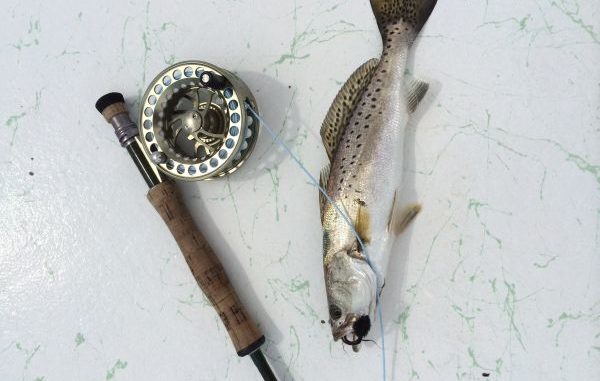
When it comes to flies, Capt. Jeff Poe is decidedly old school.
Born largely of experience, he uses a small combination of surface and sinking enticements that’s been putting fish in the boat for decades.
With a very basic, tapered leader (30- or 40-pound butt section down to 12-pound tippet with a 20- or 25-pound shock leader) and floating line to match the rod weight (8- or 9-weight), Poe is able to effectively probe from the surface to about 6 feet deep, which is what he considers “fun” for the limited time he has to do fly trips for pleasure.
Poe has confidence in all four of the flies, but its apparent he has a special place in his heart for the Deceiver, a subsurface, bulky, somewhat hard-to-cast fly whose combination of natural material literally comes alive in the water.
It’s also a terrific comp for the Paul Brown (Corkie) and other suspending twitch baits that have become so popular on Big Lake.
“With a Deceiver, if you tie it with the right amount of deer hair, it’ll suspend,” Poe said. “It’ll be down 6 inches to a foot and just hover there. That’ll definitely trigger a bite.”
But the venerable Clouser minnow is likely the most-effective overall speckled trout fly. Its weighted eyes allow it to move through the water column more quickly, and its small profile allows it to be cast easily with any fly line.
Fly tiers with a good source of colored material and attention to detail can come incredibly close to an exact replica to the baitfish they’re trying to imitate.
Surface flies include the familiar popper, with its concave head for making a disturbance on the water. Poe also uses a more-subtle temptation called the Slider that can be equated to a lipped jerk bait in conventional tackle terms. The more-finesse approach to a surface imitation can be key when fish are interested in the idea of a surface strike, but are being picky.
“With the Slider, it floats, and then when you strip it dives below the surface and then floats back up,” Poe said. “And it makes a lot of bubbles. Sometimes when they won’t hit that popper, they’ll hit the slider.”
The use of poppers with its visual payoff to the angler is obviously the most fun to most fly anglers, but Poe said there’s an overlooked benefit to making noise on the water’s surface in order to manufacture a bigger noise that pulls back on the angler.
“A lot times you can do real well with a popper in the dirtier water,” said Poe. “In the winter we’ll get some calm days but still dirty water because of rain.
“That’s when we’ll get some fish on poppers. It’s really the only way the fish can find a fly.”
One common attribute to all flies in Poe’s arsenal is color. Olive green is the dominant shade, but he said that’s more out of comfort and confidence in the color than any particular measure of effectiveness.
“I like olive, but there are a lot of different colors that will work that are the exact opposite,” he said. “Plenty of pink and orange flies work really well. Those loud colors will really work.
“(Olive) is just one of those colors I really like, even when I’m fishing conventional gear.”